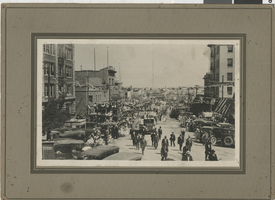Search the Special Collections and Archives Portal
Search Results

Las Vegas Wash at the Clark County Wetlands Park, Clark County, Nevada: digital photograph
Date
2016-07-09
Archival Collection
Description
Water flows down the Las Vegas Wash at the Clark County Wetlands Park.
Image

Garbage along the Las Vegas Wash at the Clark County Wetlands Park, Clark County, Nevada: digital photograph
Date
2016-07-09
Archival Collection
Description
Garbage deposited during the last flood lines the banks of the Las Vegas Wash at the Clark County Wetlands Park.
Image

Las Vegas Wash at the Clark County Wetlands Park, Clark County, Nevada: digital photograph
Date
2016-07-09
Archival Collection
Description
Late afternoon light highlights the feature of the Las Vegas wash as it flows through the Clark County Wetlands Park.
Image

Garbage along the Las Vegas Wash at the Clark County Wetlands Park, Clark County, Nevada: digital photograph
Date
2016-07-09
Archival Collection
Description
Garbage deposited during the last flood lines the banks of the Las Vegas Wash at the Clark County Wetlands Park.
Image

Las Vegas Wash at the Clark County Wetlands Park, Clark County, Nevada: digital photograph
Date
2016-07-09
Archival Collection
Description
The sun sets behind the Spring Mountains as the Las Vegas wash reflects the light as it flows through the Clark County Wetlands Park.
Image

Las Vegas Wash at the Clark County Wetlands Park, Clark County, Nevada: digital photograph
Date
2016-07-09
Archival Collection
Description
Dusk falls as the Las Vegas wash flows through the Clark County Wetlands Park.
Image
Stardust Gambling Museum news segments: video
Date
1987-05-08 to 1987-05-09
Archival Collection
Description
Local news segments on the Stardust's "old-time gambling museum" which houses a $3 million dollar collection put together by Boyd Gaming and part of a larger renovation. First segment interviews Ralph Purnell, Stardust General Manager, who explains why the museum was put together as a new attraction, comparing it to Imperial Palace's car collection. In the second segment, Sam Boyd is seen leading the first tour through the museum. A brief history is provided on gaming and gambling, while stills of early Las Vegas are shown. Purnell speaks again on why the museum was created. The third segment the interior of the museum and artifacts around the museum. Interview with E. J. Cummins talks about hiding these artifacts while it was illegal, and the reporter speaks with historians about various early gaming machines. Original media VHS, color, aspect ratio 4 x 3, frame size 720 x 486. From the Stardust Resort and Casino Records (MS-00515) -- Photographs and audiovisual material -- Digitized audiovisual material file.
Moving Image

Photograph of crowds of people watching a parade, Tonopah, Nevada, circa 1910s
Date
1910 to 1919
Archival Collection
Description
Crowds of people line a street decorated with American flags in Tonopah, Nevada to watch a parade, probably for Independence Day. The Tonopah Club building is seen at left center.
Image

Photograph of Dofflemyre and Lake at a barbershop in Las Vegas, circa 1900s
Date
1905 to 1939
Archival Collection
Description
Black and white image of Dofflemyre (left) and Lake (right) at a barbershop at the corner of Fremont and Main Streets where the Hotel Nevada was once located.
Image

Photograph of a decorated wagon at Tonopah Railroad Carnival, Tonopah (Nev.), early 1900s
Archival Collection
Description
Caption: Miners Drugstore Float Tonopah R.R. Carnival
Image
Pagination
Refine my results
Content Type
Creator or Contributor
Subject
Archival Collection
Digital Project
Resource Type
Year
Material Type
Place
Language
Records Classification
